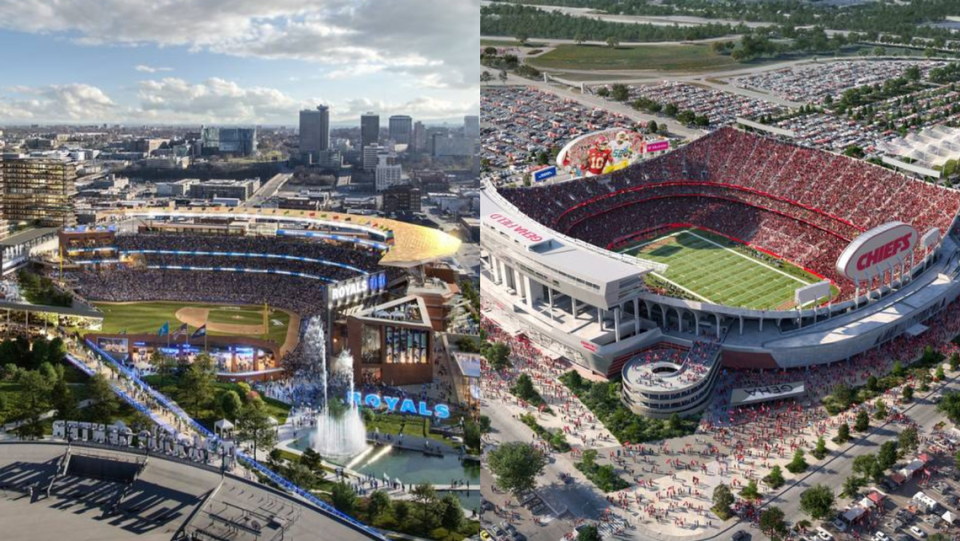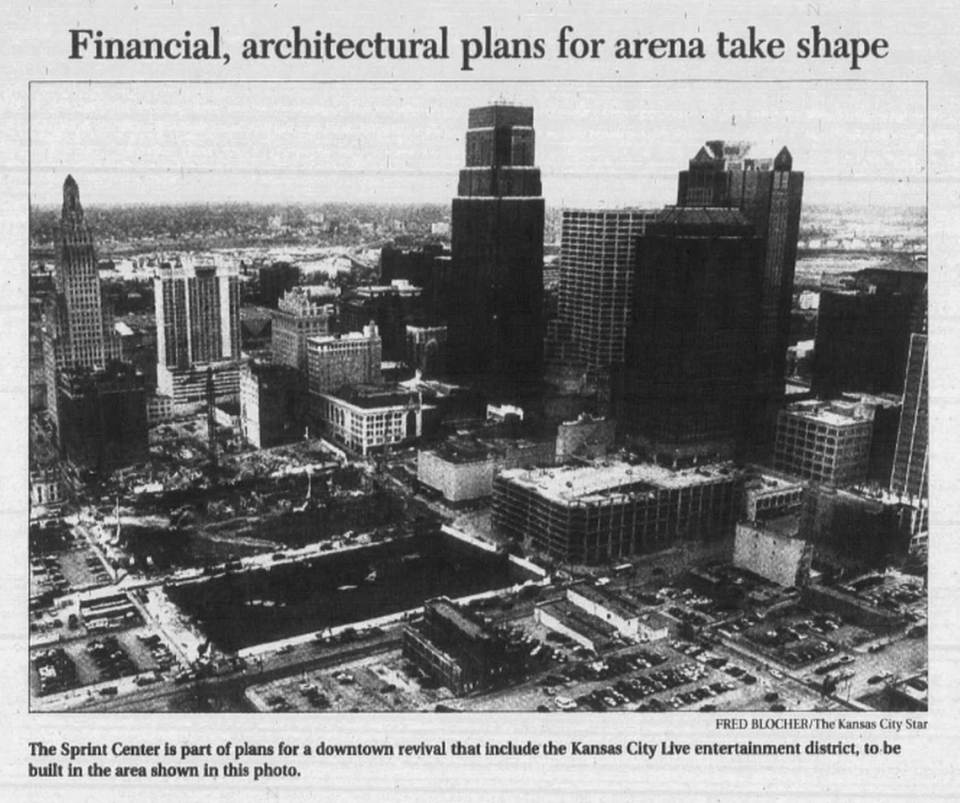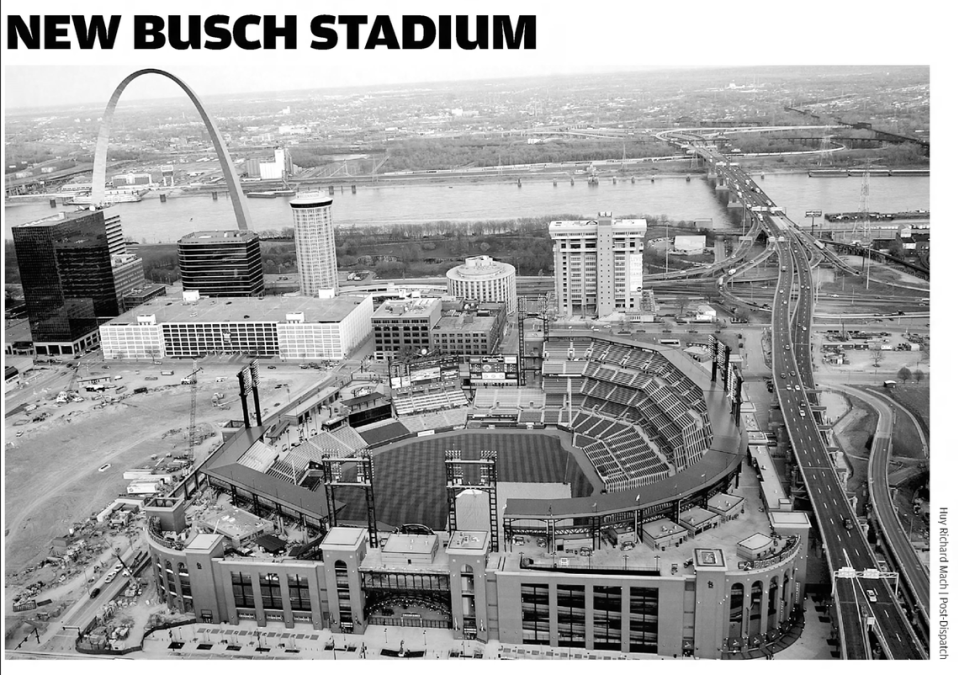How could new Royals stadium construction disrupt traffic? What similar projects show us
Whether you love or hate the idea of the Royals moving to the Crossroads, there’s no way around the fact that building a new baseball stadium would mean stop-and-go traffic and detour signs around downtown.
Both Kansas City and St. Louis had to deal with these disruptions while building the T-Mobile Center and Busch Stadium. The projects were both planned in downtown areas and featured a related mixed-use development, similar to the proposed Royals stadium.
Jackson County voters have less than three weeks to decide whether to issue a 40-year, 3/8th-cent sales tax to help pay for a new Royals stadium in the Crossroads and renovations to the Chiefs’ Arrowhead Stadium.
This new tax would replace the current tax that funds the Truman Sports Complex, which is set to expire in 2031, and the revenue would be split evenly between the two teams.
In 2004, Kansas City voters approved a tax increase to help fund the T-Mobile Center, known as the Sprint Center until 2020. After over two years of construction, the concert and sports venue opened in October 2007, with most businesses in the Power & Light District welcoming visitors in spring 2008.
After years of negotiation, the St. Louis Cardinals opened a new Busch Stadium in 2006, which replaced the old ballpark next door. Developed by the same company as the Power & Light District, the nearby Baseball Village entertainment district went through multiple iterations before the first phase opened in 2014.

While we don’t know exactly what construction for a new Royals stadium would look like, this is what we learned about how it worked for these similar projects from the archives of the Kansas City Star and St. Louis Post-Dispatch.
Size
T-Mobile Center/Power & Light District
The T-Mobile Center sits on a four-block site, and Power & Light takes up nine city blocks, according to the developer. Together, that’s 13 blocks.
Busch Stadium
Busch Stadium sits on four blocks, according to Google Maps. It is partially located on the land of the old Busch Stadium. The Ballpark Village entertainment district incorporates six blocks, so 10 blocks total.
Proposed Royals stadium
The Crossroads stadium would occupy six city blocks: Truman Road to 17th Street, Grand Boulevard to Locust Street.
Timeline
T-Mobile Center/Power & Light District
Voters approved a tax increase to fund the project in August 2004. Crews broke ground 10 months later. The ribbon cutting was held in October 2007, about three years after the vote. Construction on the T-Mobile Center and Power & Light District happened at the same time.
Busch Stadium
Crews broke ground in January 2004, after years of negotiations. Just over two years later, the Cardinals held their first game in the new Busch Stadium.
Ballpark Village was developed by Cordish Companies, who also led Kansas City’s Power & Light District. Construction on the first phase began in early 2013 and opened to the public a year later. After two and a half years of construction of phase two, the $260 million expansion opened in June 2020.
Proposed Royals stadium
Royals officials plan to open the proposed Crossroads ballpark for the 2028 season, in about four years.

Traffic
T-Mobile Center/Power & Light District
A section of Grand Boulevard was closed for about five months in 2006.
At the time, Star readers and columnists complained about the “zoo” of downtown traffic, with roads closed for construction of the H&R Block headquarters, Kauffman Center and the seven-block Power and Light District all around the same time.
Kansas City Star reporter Kevin Collison wrote in a March 2006 article, that for the next year and a half, “motorists are at the mercy of the folks in charge of putting up the ‘Detour’ and ‘Road Closed’ signs.”
Star columnist Lewis W. Diuguid wrote on January 4, 2006 that dust and mud were a nuisance to downtown visitors. “A good rainfall only turns the finish to a muddy mess…“Pedestrians and bikers still get sandblasted with dirt coming from the pit.”
Busch Stadium
The project permanently shut down a highway ramp, which was on the site of the stadium, in addition to a street that ran through the stadium’s footprint. The ramp was later relocated.
Lanes were temporarily closed for two blocks and drivers had to use alternate routes in and out of downtown St. Louis.
Proposed Royals stadium
According to renders the Royals shared, the proposed stadium would close the Oak Street bridge and overpass.
Construction could affect the streets surrounding the development, Grand Boulevard, Truman Road, and Locust and 17th streets.

Effect on businesses
T-Mobile Center/Power & Light District
Some area businesses closed while others moved to the area.
On October 7, 2007, Joyce Smith wrote for The Star, “For scores of entrepreneurs big and small who have placed their bets downtown, the wait for the Sprint Center is almost over.”
Busch Stadium
The effects of stadium construction on local businesses was unclear, from St. Louis Post-Dispatch reporting at the time.
Proposed Royals stadium
The Royals development would displace at least eight restaurants, seven shops and 12 other organizations. The former Kansas City Star printing facility would be demolished as well.
Some Crossroads businesses said they were concerned about higher rents and having to relocate if a stadium came to the neighborhood. However, some developers said they could profit from selling their properties as values rise.
Have more questions about the Jackson County stadium vote? Ask the Service Journalism team at kcq@kcstar.com.

